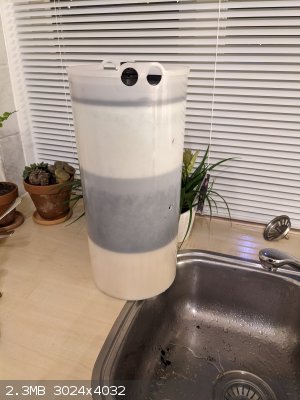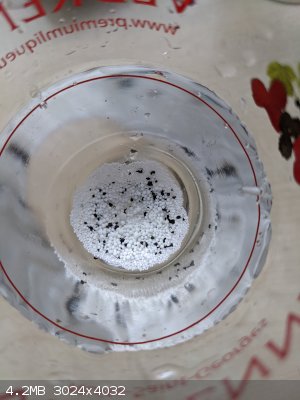
Tsjerk - 14-1-2022 at 13:48
I picked up a spent Brita water filter from friend's company. It seems to contain three kinds of resin. But I'm wondering how to find out which is
which.

I drilled some holes and got some of the resin out.

The first thing I tried was putting all three together and suspend them in saturated NaCl. The yellow one on the left almost floats, but not
completely. The white and black definitely sink.
Any idea what the different resins could be? I could try adding some dilute acid/base and see which neutralize which, but from that point on I
wouldn't know what the differences could be.
It is a "purity 1200 clean extra" Brita filter.
[Edited on 15-1-2022 by Tsjerk]
crow6283 - 14-1-2022 at 14:32
The one on the left very much LOOKS like the cation exchange resin I ordered a kilo of a couple years ago but that doesn’t mean much. Also LOOKS
very much like the similar kind that is used in water softeners.
Dr.Bob - 14-1-2022 at 18:19
Are you sure that the pure black is not activated charcoal or carbon? That is often in filters to absorb organics and several specific bad things.
I have used anionic and cationic resins and both are amber colored typically. You could try to find some colored, charged, molecule like
nitrophenol and see which one binds it better. Maybe nitrobenzoic acid for the other one.
SWIM - 14-1-2022 at 18:53
Brita does emphasize the carbon (from coconut shells), used in their filters.
Tsjerk - 15-1-2022 at 00:52
I'm pretty sure the black stuff is resin, see this picture:

The carbon seems to be in the top white layer, which might be a mixture of carbon with two kinds of resin (smaller and bigger beads). I now had a
better look at the top white layer and it very much reminds me of the cheap knock-off cartridges I got from a b-brand supermarket some time ago. In
these cartridges the anionic and cationic resin are mixed together with carbon. Those resins I was also not able to separate in a NaCl solution.

Good idea Dr.Bob! I have some trinitrophenol laying around somewhere. I would have to look around for a colored cation, but I guess when it does not
absorb TNP but it does neutralize acid it should be clear as well.
My TNP is in storage somewhere else, but I have dichromate where I am now, so I could give that a try first.
[Edited on 15-1-2022 by Tsjerk]
Tsjerk - 15-1-2022 at 23:31
The brown/black resin is cation resin, it didn't bind TNP, but it does bind acid (after being saturated with NaCl). The solution clearly became less
acidic after stirring with the beads. After adding some NaCl it became more acidic again.
The small amber colored beads did absorb TNP, and released the TNP after adding NaCl.
I don't know what the white irregaly sized beads are, they don't absorp TNP, I didn't check what they do with acid yet.
